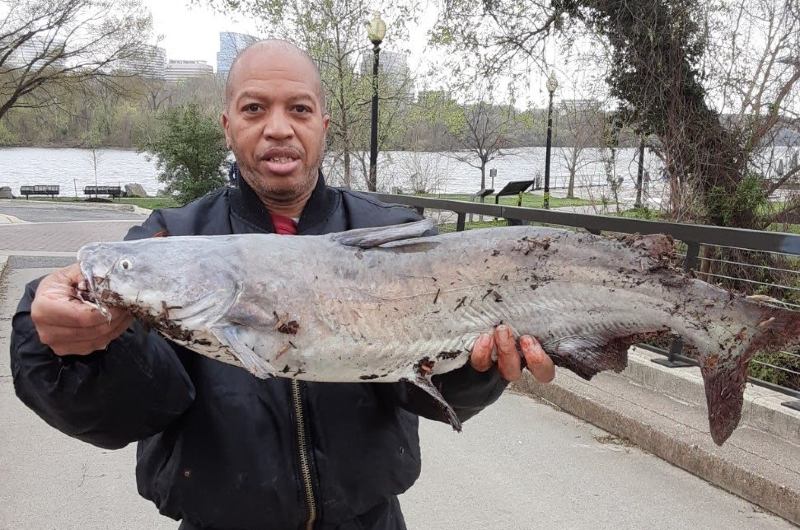Some people believe you can teach a man to fish. I believe fishing is something that teaches. In my previous column, I wrote what inspired me about fishing. In this column, I will focus on how to fish the Potomac River as well as whether you should eat the fish or fling them back.
The Potomac remains an anomaly. America’s most famous river is also the nation’s least appreciated river. It runs 380 miles beginning in the Allegheny Mountains and emptying in the Chesapeake Bay at Havre de Grace, Maryland.
The Upper Potomac offers big brown, rainbow trout, pike, and muskies. Lower Rock Creek Park and Georgetown, where I fish, offer giant carp, herring, shad, snakeheads, rockfish, bass, and monster catfish.
While some like to fish the giant Potomac, I prefer streams and canals because the fish follow the herring and perch that spawn during the spring. While anglers prefer fishing in daytime hours, these times are not lucrative in catching trophy size fish. Big fish like cooler deep waters and will not feed when the water temperature rises. The best time to catch trophy fish is an hour before dusk or sunrise.
If fishing in the DC area or Lower Potomac, this isn’t fresh water but tidal water. Before I plan my fishing trip, I check the tide charts, but in some places it doesn’t matter if the herring or bait fish are in, the fish will be gorging themselves. If you plan on boating or canoeing and you’re a novice, I suggest obtaining a guide because there are underwater currents, places where boats have disappeared and people have drowned. The most experienced hands can get befuddled navigating the Potomac.
I privately have secret fishing spots outside the river, where there’s no civilization and the water isn’t as polluted as the DC metropolitan area. Because I work near my fishing spot, I like to grab my rod after work, and I’m lucky enough to be near a 24-hour Safeway where I can grab chicken, liver or fish, good for catching catfish or big bass, if biting. If you want to catch everything from bass to big cats, use gulp bait. I swear by this over any lure.
I have fished all over the Potomac, but my preferred place is Thompson’s Boathouse. When fishing, be aware of whom you divulge information to or get shocked seeing that person with a rod and reel fishing in your spot.

When fishing at night, I carry three to five rods. Catfish are funny feeders: sometimes they crush liver, while other times they will lose their minds with shrimp or cut bait. While known as bottom huggers, when the shad and herring come in, the river is alive with giant popping sounds.
This is where I have my light rod or Ugly Stick. I tie on a gulp bait with a feather jig. It’s all in the technique. You have to make it look like a swimming fish for a bass to hit it. I also like to use frog or popping lures when I see the fish splashing. Another tip is to bring rod holders and a good net if you’re fishing off a bridge or bulkhead.
Failure to prepare is preparing to fail
I learned catching fish starts long before you throw a line in the water. Nothing is more frustrating than fishing at night, seeing fish jump, and not having your lines ready. My fishing trip starts the day before. Catfish fishing can be treacherous. They live under stumps and boulders. I fill my tackle box with sinkers, small and sometimes as heavy as 6 ounces, depending on current. Rockfish like fast-moving water and bridges, so it can be expensive buying lures for bass. What worked for me was shrimp. I caught trophy-sized rockfish in New Jersey, where they are called stripers.
Rockfish have a ferocious hit so when they strike, you have to set the hook fast or they’ll drop the hook. With catfish, you have to have patience. That’s why I have rod holders. Sometimes you have to wait twenty-thirty minutes before you set the hook. I would rather have a rod holder so I can read a book or play video games. When it looks like my line headed for the river, I know he’s hooked good and hard.
What to do when you catch them?
I’m often asked whether I eat the fish. My advice if you’re going to eat catfish, eat the smaller ones, from three to five pounds. Big catfish have homes and don’t venture from them so all the toxins get in their bodies; the smaller ones are flighty, so they taste better. Stripers, walleyes, and pan fish such as crappies live in cleaner water, Snakeheads like clean streams, so eating them is ok. Some people eat carp, soft-shell turtles, and terrapins that are part of the Potomac. If you know how to cook them, they are edible.
Prepare your fish, especially catfish!!
I’m not a catfish eater but the best way to cook them is to marinate them in buttermilk, add vinegar and lemon juice, and wait for about seven hours to get the toxins out. With stripers and walleye, I fillet them. Some love frying the whole fish bone-in. I prefer fillets. While I prefer fish out of the ocean, I’m a sucker for a nice walleye or bass.

My last piece of advice is, know the laws and rules before throwing a line in the river. With some fish, like snakeheads and flathead catfish, you must kill them if they are caught and you will have excellent table fare. Bass, shad, and walleyes have size and catch limits. Get a license, so the game warden doesn’t creep on you. If using a boat, keep in mind that some areas don’t allow gas motors.
As you see, there is more to fishing than throwing a line. The moon, stars and weather play active roles in fishing. It’s important to prepare and know what to fish for, as well as where you’ll find the best opportunities for big fish.
Stay tuned. Hopefully, I will catch more fish this summer.







